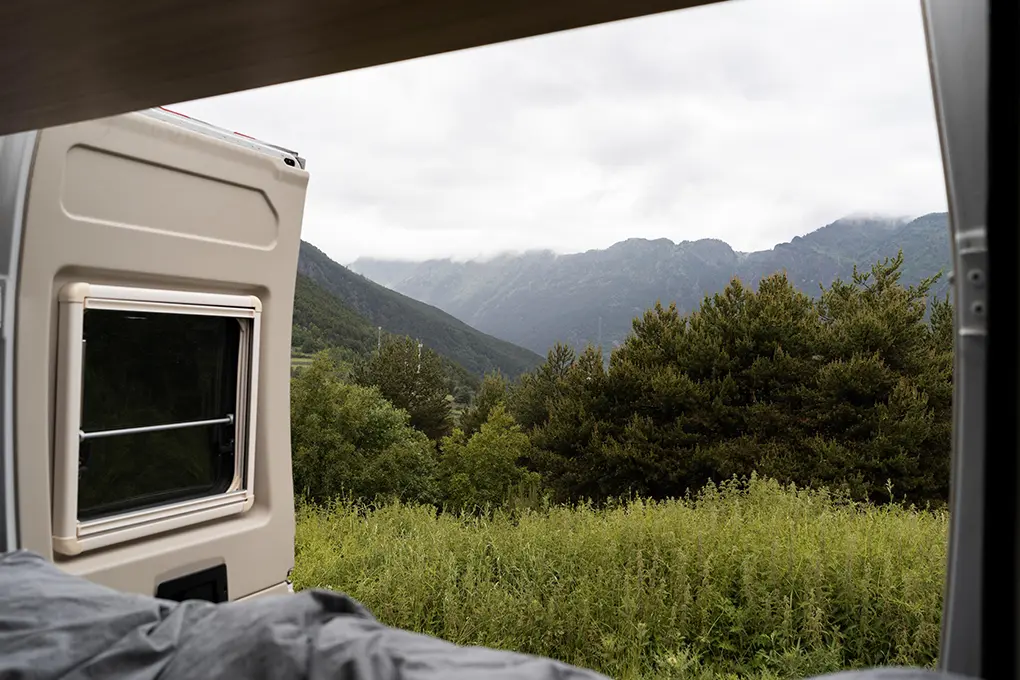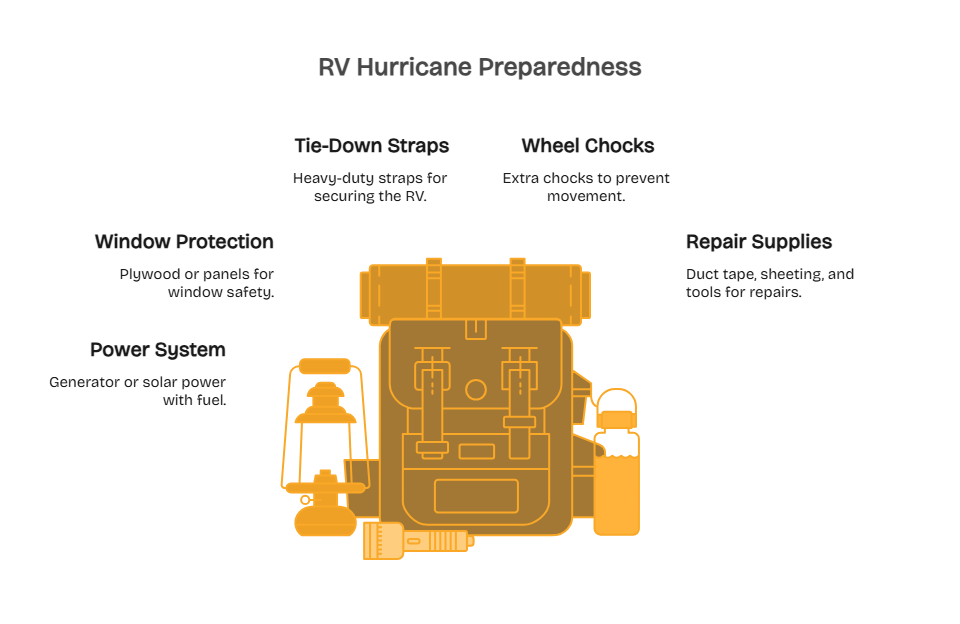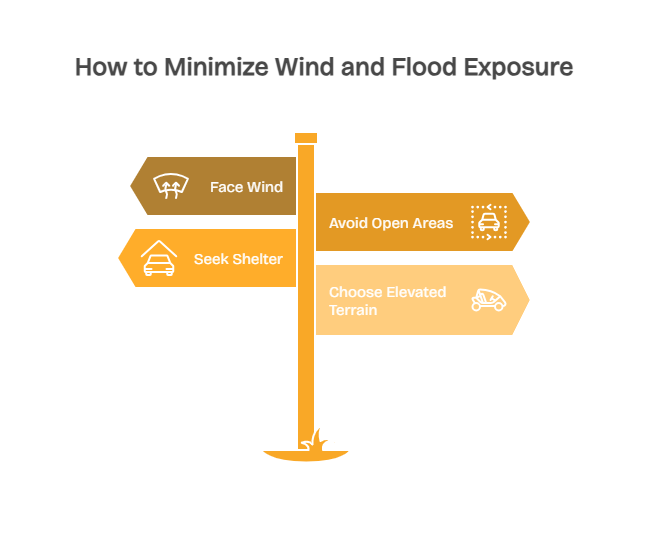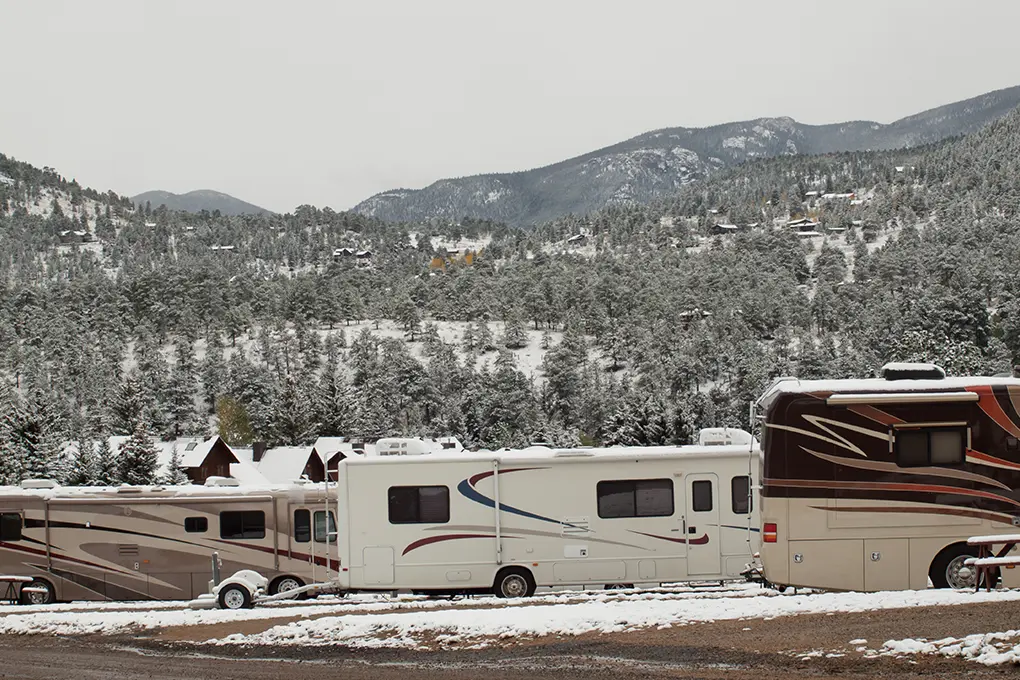Quick Answer: To prepare an RV for a hurricane, secure it with hurricane straps, retract slide-outs, and park nose-first into the wind on elevated ground. Stock 7–10 days of food, water, and emergency supplies, and create an evacuation plan with inland routes. Proper preparation and early action are key to RV hurricane safety.
Hurricane season brings serious risks for RV owners – especially since these vehicles are built for movement, not for standing up to 160 mph winds, flying debris, or flooding. As of 2024, 11.2 million U.S. households own RVs, a 62% jump in 20 years, meaning millions of families now face growing storm threats to their mobile investments.
The numbers show how high the stakes are: the 2024 hurricane season saw 27 billion-dollar disasters causing $182.7 billion in damages. Hurricane Milton alone caused $34 billion in losses, while Helene inflicted $78.7 billion to as much as $250 billion in total economic damage. Since 1980, tropical cyclones have generated over $1.5 trillion in losses – an average of $23 billion per event.
With the RV industry valued at $47.8 billion and about 1 million Americans living full-time on the road, proper hurricane preparation is essential to protect lives, property, and the freedom that RV living represents. Let’s find out how to prepare an RV for a hurricane.
Table of Contents
- Key Takeaways
- Hurricane Threats to RVs: Why Standard Preparation Isn’t Enough
- Pre-Hurricane Planning: The Foundation of RV Safety
- Immediate Pre-Storm Preparation (72-48 Hours Before)
- Emergency Supply Management
- During the Hurricane: Staying Safe in Extreme Conditions
- Long-Term Hurricane Protection Strategies
- Regional Considerations and Special Circumstances
- Advanced Preparation: Technology and Innovation
- Financial Planning and Recovery
- How to Secure an RV During a Hurricane – Staying Safe During the Storm
- Frequently Asked Questions
- Sources
Key Takeaways
- Preparing an RV for a hurricane involves evacuation planning, securing systems, and self-sufficiency for power, food, and water.
- RVs are highly vulnerable to wind and flooding, with most unable to withstand winds above 75 mph or even minimal storm surge.
- Early evacuation is safest; use inland routes and pre-book RV-friendly shelters before highways become congested.
- Securing your vehicle with hurricane straps for RVs and tie-down systems reduces tipping and wind damage.
- Maintaining full water, propane, and battery capacity helps your RV function independently during extended outages.
- Documenting pre-storm conditions and keeping comprehensive insurance coverage ensures faster, fairer claim settlements.
- For reliable emergency gear, weather radios, and hurricane safety bundles, turn to Batten for expert-recommended solutions that keep your RV and family safe.
Hurricane Threats to RVs: Why Standard Preparation Isn’t Enough
RVs face hazards during hurricanes that most homeowners never have to consider. Their lightweight materials and tall, boxy design make them especially prone to wind damage and flooding. While ideal for mobility, these same traits become liabilities in extreme weather.

Wind Risks and Structural Weakness
High winds are the biggest danger. Because of their height and broad sides, RVs can sway, lift, or even flip in conditions far milder than those that damage houses. Most are not built to withstand sustained winds above 75 mph, and even moderate gusts can cause instability. Positioning the vehicle nose-first into the wind and using stabilizers can greatly reduce this risk.
Water Damage and Flooding
RVs are not sealed like permanent structures. Roof seams, vents, and window seals can easily fail during heavy rain, and the low clearance leaves them vulnerable to flash floods and storm surge. Once water seeps into flooring or electrical systems, repairs can be costly or impossible.
Evacuation and Mobility Challenges
Mobility can quickly become a disadvantage once a hurricane warning is issued. RV owners must decide when to evacuate, where to go, and how to avoid clogged highways or fuel shortages. Waiting too long can trap large vehicles on unsafe roads, while leaving early requires constant monitoring of storm tracks and evacuation orders.
Pre-Hurricane Planning: The Foundation of RV Safety
Effective hurricane preparation starts well before a storm develops. The most prepared RV owners create detailed emergency plans during calm weather, identifying routes, supplies, and insurance details long before hurricane warnings appear.
Evacuation Route Planning
Every RV hurricane plan should assume evacuation. Map multiple inland routes from your usual locations, avoiding coastal roads and flood-prone areas. Use tools like Google Maps to mark alternate paths in case highways close or traffic builds.
Identify RV-friendly destinations such as inland campgrounds, state parks, and national parks that allow large vehicles. These fill quickly during storm alerts, so consider making refundable reservations during hurricane season.
Batten Emergency has seen firsthand how a lack of planning can turn dangerous. Documenting a clear route – complete with mile markers, fuel stops, and triggers for departure – prevents this chaos. For example: “If sustained winds reach 65 mph or authorities issue evacuation orders, depart immediately via Route X to Campground Y, with backups Z1 and Z2.”
Hurricane Season Preparation Checklist
Preparation should begin before hurricane season. Keep a permanent hurricane kit in your RV with:
Essential Supplies
- 7-10 days of non-perishable food per person
- 1 gallon of water per person per day (minimum 7 days)
- Prescription medications (30-day supply)
- First aid kit with trauma supplies
- NOAA weather radio (battery or hand crank)
- Flashlights with extra batteries
- Portable phone chargers and power banks
- Waterproof container for important documents
- Cash for fuel and emergency purchases
RV-Specific Equipment

- Heavy-duty tie-down straps rated for hurricane winds
- Extra wheel chocks
- Plywood or storm panels for large windows
- Duct tape, plastic sheeting, and repair tools
- Portable generator or solar power system with fuel supply
Insurance and Documentation Preparation
Review your RV insurance policy annually to confirm hurricane coverage. Most comprehensive policies include protection for wind and debris damage but may exclude flooding or open-window exposure. Some insurers also require proof of reasonable storm preparation for claims approval.
Document your RV’s condition before hurricane season with clear photos and videos inside and out, storing them securely in cloud storage. Include serial numbers for electronics and appliances.
This documentation can significantly improve settlement outcomes – families with pre-storm records in 2024 averaged $3,811 per household in faster, higher settlements.
Keeping thorough documentation and an updated inventory ensures you can file claims quickly and accurately, even if your RV sustains severe damage.
Power through any storm with Batten’s backup generators, solar kits, and emergency power options.
Immediate Pre-Storm Preparation (72-48 Hours Before)
When a hurricane threatens, the final 72 hours are critical for both safety and minimizing damage. Knowing how to prepare an RV for a hurricane starts with informed decision-making and fast, organized action.
Monitoring and Decision Making
Modern hurricane forecasting has improved dramatically, but rapid shifts in track or intensity are still common. Follow official updates from the National Hurricane Center, local National Weather Service offices, and state emergency management agencies. Avoid relying on unofficial reports or social media commentary.
Set clear evacuation triggers in advance, such as leaving if a Category 2 or stronger storm is projected to pass within 100 miles. Having firm criteria removes hesitation and keeps decisions objective. The 72-hour mark is often the last window for a safe evacuation before conditions deteriorate.
The 2024 hurricane season showed how quickly storms can intensify. Hurricane Milton, for example, strengthened from a tropical storm to a Category 5 in just 48 hours – demonstrating why early, proactive evacuation remains the safest choice for any RV hurricane scenario.
Securing Your RV Location
If evacuation isn’t possible, the way you position and secure your RV can make a major difference.
To minimize wind and flood exposure

- Park with the front end facing into the prevailing wind direction
- Avoid open fields or areas near large trees
- Seek partial shelter beside a sturdy concrete structure
- Choose elevated terrain to reduce flood risk
This setup follows the “airplane rule,” positioning your RV nose-first into the wind to reduce its exposed surface area.
Structural Preparations and Tie-Down Systems
Every external feature of your RV needs to be secured. Retract slide-outs and awnings completely, since they catch wind like sails and can tear from their mounts. Bring all outdoor items inside, including chairs, grills, and decorations, as these can become hazardous projectiles.
For maximum stability, use hurricane straps for RV models equipped with ground anchors. If your site provides tie-down points, install professional-grade tie-down kits that use steel cables or straps to anchor your RV to augers or concrete pads. Learning how to tie down an RV for hurricane conditions is one of the most effective ways to prevent tipping or lift.
Final Safety and Supply Checks
Ensure your emergency kit includes:
- A NOAA weather radio and extra batteries
- At least 7 days of water and non-perishable food
- Medications and first-aid supplies
- Portable chargers and backup power sources
With each passing hour, storm conditions can shift rapidly. Acting early, securing your RV properly, and maintaining communication through reliable channels give you the best chance of staying safe when severe weather strikes.
Emergency Supply Management
Hurricane preparation for RV owners goes far beyond normal camping readiness. A well-equipped RV must function as a self-sufficient shelter for days – or even weeks – without external power, clean water, or emergency services.
Water System Preparation
Start by filling your fresh water tank completely. Municipal water systems often fail during hurricanes because of power outages or contamination. Stored water becomes vital for drinking, cooking, and hygiene.
Plan for at least 1.5 to 2 gallons of water per person per day to account for heat, cleaning, and stress-related usage. Empty your gray and black tanks before the storm to maximize capacity and extend your RV’s livability if dump stations become inaccessible.
The 2024 hurricane season showed just how fragile utilities can be. When Hurricane Beryl hit Texas, millions lost power for several days, while Helene’s flooding in North Carolina disrupted water service for weeks. RVs with full tanks and backup filtration systems remained functional long after local infrastructure failed.
Power and Fuel Systems
Charge all RV batteries fully and test them before the storm. Reliable 12-volt power supports lighting, water pumps, and communication equipment. If batteries are old or weak, upgrading to lithium systems provides longer runtime and faster charging.
Fill propane tanks completely and confirm all appliances work properly. Propane may be your primary fuel for cooking, heating, and refrigeration during extended outages. Ensure proper ventilation and test carbon monoxide detectors before using propane indoors.
If your RV includes a generator, test it under load and stock stabilized fuel in approved containers. Fuel shortages are common immediately after major storms, so having solar or hybrid power options offers crucial independence.
Food and Medical Supplies
Stock enough non-perishable food for at least seven days. Include items that don’t require cooking or refrigeration, along with familiar comfort foods to help maintain morale.
Keep a 30-day supply of prescription medications and a variety of over-the-counter essentials such as pain relievers, allergy medications, and antacids. Pharmacies and clinics may remain closed for days after a hurricane.
Upgrade your first aid kit with trauma supplies, including tourniquets, bandages, antiseptics, and splints.
During the 2024 season, tornadoes spawned by Hurricane Milton caused widespread injuries that overwhelmed local emergency services. Having advanced first aid equipment and basic medical knowledge allows you to handle minor or moderate injuries when professional help is delayed.
During the Hurricane: Staying Safe in Extreme Conditions
Once hurricane conditions begin, the focus shifts from preparation to survival. The decisions you make now directly affect your safety and your RV’s chance of remaining intact.
Shelter and Safety Protocols
RVs are not designed to withstand hurricane-force winds and should never be treated as safe shelters. If you have not evacuated, move immediately to a designated storm shelter or a sturdy permanent building. Many coastal RV parks partner with local emergency facilities, but you must confirm these arrangements well before hurricane season.
If evacuation becomes impossible, stay in the most structurally secure area of your RV – preferably near the center, away from windows and slide-outs. Keep low to minimize injury risk if the RV shifts or sustains impact.
Monitoring and Communication
Maintain constant weather updates through a battery-powered NOAA radio or trusted alert apps. Hurricanes can spawn tornadoes and flash floods without warning, and official advisories provide life-saving guidance.
Keep phones and radios charged using solar chargers, 12-volt adapters, or backup batteries. Conserve power for emergencies, and maintain contact with family or emergency personnel when possible.
If conditions allow, take brief photos or videos of damage for insurance documentation – but never endanger yourself to do so.
Post-Storm Safety and Damage Assessment
Dangers persist long after the hurricane passes. Floodwaters, unstable trees, and downed power lines create hidden threats. Before exiting your RV, check for standing water, debris, and fallen wires. Treat all power lines as live until confirmed otherwise by utility crews.
Inspect your RV carefully before moving it:
- Frame, walls, and roof integrity
- Windows and seals for leaks or cracks
- Tires, suspension, and hitch components
- Electrical wiring and battery systems
- Propane lines and fittings for damage or leaks
If you find significant structural or system damage, document it thoroughly before attempting repairs or relocation. Accurate post-storm documentation will help verify insurance claims and speed recovery once it’s safe to proceed.

Long-Term Hurricane Protection Strategies
For RV owners who live or travel in hurricane-prone regions, long-term preparation goes beyond short-term checklists. Investing in the right equipment and infrastructure can greatly reduce storm-related damage and long-term repair costs.
Equipment Upgrades and Modifications
Consider reinforcing your RV with hurricane-resistant features if you regularly face storm threats. Upgrades like impact-resistant windows, reinforced doors, and stronger tie-down points can dramatically improve structural integrity.
Although these additions require an upfront investment, they can prevent costly losses during major weather events.
Install a reliable surge protection system to safeguard electrical components from post-storm power fluctuations. A single surge can destroy control circuits or appliances, leading to expensive repairs.
Upgrading your emergency power setup with lithium battery banks or solar charging systems increases self-sufficiency. These modern systems recharge quickly and maintain power for longer periods when grid access is limited.
Site Preparation and Secure Storage
For RVs stored seasonally or semi-permanently, proper site preparation is crucial. A well-built carport or steel-framed RV shelter can protect against hail, wind, and debris impact. Always verify that any structure meets local wind-load engineering standards and is securely anchored to prevent lift.
Professional-grade tie-down systems remain one of the best defenses against high winds. These typically use ground anchors with steel straps or cables to stabilize the RV and prevent shifting or overturning.
If you live in areas with frequent hurricanes, consider off-season storage in climate-controlled or reinforced facilities. Although storage comes with a cost, it may be far less than the deductible or repair expense after a severe storm.
Regional Considerations and Special Circumstances
Hurricane preparation for RV owners varies widely by location. Geography, local infrastructure, and regional emergency procedures all influence the best strategies for safety and evacuation. Understanding these regional differences helps you prepare more effectively.
Gulf Coast Considerations
The Gulf Coast faces the most frequent and intense hurricane activity in the United States. Warm Gulf waters fuel rapid storm intensification, sometimes turning tropical storms into major hurricanes in less than a day. Because of this, RV owners along the Gulf should remain ready to evacuate at any time during hurricane season.
Storm surge poses the greatest danger. RVs sit low to the ground and can easily be lifted or swept away by just a few feet of rising water.
Surge often carries debris that damages frames, electrical systems, and undercarriages, even if the vehicle remains upright. For safety, park only in elevated inland areas and never near bays, rivers, or coastal flats once a storm warning is issued.
Atlantic Coast Challenges
The Atlantic Coast usually provides more advance warning before landfall, but its dense population makes evacuation far more complicated. Major coastal highways quickly gridlock once official evacuation orders begin.
RV owners should identify inland routes that bypass major metro areas and plan alternate destinations in less congested regions.
Topography along the East Coast also affects storm behavior. Flat coastal plains experience strong, sustained winds, while inland ridges and valleys can create wind channeling that increases gust strength. RVs parked near hill gaps, bridges, or open valleys may face higher wind loads than nearby sheltered areas.
Insurance and Legal Requirements
Insurance coverage for RV hurricane damage differs by provider. Most comprehensive RV policies include wind and debris coverage, but many exclude flooding or storm surge damage unless you carry separate flood insurance.
Review your policy annually, confirm exclusions in writing, and consider adding umbrella coverage if your RV represents a major asset.
Many coastal RV parks and campgrounds have strict evacuation policies tied to local emergency management orders.
Staying on-site after a mandatory evacuation can violate park rules and may void insurance coverage. Always follow local directives and verify in advance whether your campground participates in regional hurricane shelter or relocation programs.
Advanced Preparation: Technology and Innovation
Modern technology gives RV owners powerful tools for hurricane preparation, monitoring, and recovery. From precision weather tracking to smarter energy systems, innovation plays a growing role in protecting both vehicles and occupants.
Weather Monitoring Technology
Professional-grade weather stations and smart monitoring tools can deliver localized data more accurate than standard forecasts. Systems that measure wind speed, barometric pressure, and rainfall provide early warning of worsening conditions, allowing timely evacuation or sheltering decisions.
Satellite-based communication systems, including devices like Garmin inReach and Starlink, can transmit weather updates and SOS messages even when cell networks fail. For RV owners in remote or rural hurricane zones, these tools provide reliable connectivity and life-saving communication during extended outages.
Smart Home Integration
Smart RV systems now automate many hurricane-readiness tasks. Some models feature sensors that retract awnings when winds exceed safe limits, while others allow owners to monitor temperatures, tank levels, or battery capacity remotely. These technologies reduce the risk of mechanical damage when storms arrive unexpectedly.
Advanced battery management systems also protect against over-discharge and power loss, optimizing energy use during long outages. For full-time travelers or those storing RVs off-site, remote monitoring adds valuable oversight when physical access is limited.
Financial Planning and Recovery
Hurricane damage to RVs can cause major financial strain, making proper coverage and recovery planning essential. Standard auto or homeowner’s insurance rarely provides adequate protection for RV hurricane losses, so comprehensive or agreed-value RV policies are strongly recommended.
Agreed-value coverage guarantees a fixed payout for total loss, avoiding depreciation disputes that often reduce settlements. Maintain updated documentation of all upgrades, electronics, and personal property to ensure full compensation after a storm.
Post-Hurricane Recovery Planning
Repair and recovery after major storms can take weeks or months, especially when local service centers are overwhelmed. Establish relationships with trusted RV service providers before hurricane season to secure faster repairs if damage occurs.
Plan for temporary housing costs and ensure your insurance policy covers alternative accommodations. Many RV clubs and national organizations offer emergency support, temporary housing discounts, and roadside assistance programs that can ease recovery efforts.
Long-Term Preparedness and Safety
Comprehensive hurricane preparation combines technology, insurance, and planning. Regularly test systems, review policies, and update your evacuation strategy each year. Even the best-equipped RV cannot safely withstand hurricane-force winds, which makes timely evacuation your most critical safety measure.
When evacuation is not possible, strong preparation can reduce losses and improve safety outcomes. From hurricane straps and power systems to remote monitoring tools, each precaution adds another layer of protection. Above all, remember that no RV is worth risking your life – property can be replaced, but people cannot.
How to Secure an RV During a Hurricane – Staying Safe During the Storm
Preparing an RV for a hurricane requires foresight, organization, and decisive action. From pre-season planning and supply management to evacuation readiness and post-storm recovery, every step helps protect both your investment and your safety.
Positioning your RV correctly, learning how to secure an RV in a hurricane, and maintaining reliable power and communication systems can make a life-saving difference. Regular policy reviews and the use of modern weather and monitoring technology also strengthen long-term protection.
Stay proactive, keep your emergency kits stocked, and trust Batten’s expert tools and preparedness resources to help you weather every storm with confidence.
For comprehensive emergency preparedness resources and expert-vetted equipment to protect your RV and family during hurricane season, explore our emergency preparedness bundles and hurricane preparation guides.
Frequently Asked Questions
How Do I Secure an RV in a Hurricane?
To secure an RV in a hurricane, park nose-first into the prevailing wind and use hurricane straps for RV models with ground anchors. Retract all awnings and slide-outs, lower stabilizers, and bring loose items indoors. Securing your RV correctly limits movement, prevents lift, and reduces the risk of major structural damage.
What Is the Safest Way to Tie Down an RV for a Hurricane?
Knowing how to tie down an RV for a hurricane is essential. Use steel cables or straps anchored into the ground with augers or concrete tie-down points. Tighten the straps evenly and check for slack before the storm. This stabilizes the vehicle and minimizes shifting from strong gusts or partial lift.
Can I Stay Inside My RV During a Hurricane?
No. Even well-secured RVs cannot withstand hurricane-force winds or storm surge. Evacuate early to a designated storm shelter or reinforced building. If evacuation is impossible, remain low in the most central area of the RV, away from windows and slide-outs, and keep communication devices within reach at all times.
How Can I Prepare an RV for a Hurricane If I Can’t Evacuate?
If evacuation isn’t possible, learn how to secure an RV during a hurricane by facing it into the wind, securing tie-downs, and parking on high ground. Fill your fresh water tank, charge all batteries, and verify propane levels. Preparing your RV for a hurricane in advance reduces risk until conditions improve.
What Should I Include When Preparing My RV for a Hurricane?
When preparing an RV for a hurricane, pack seven to ten days of food, 1.5 – 2 gallons of water per person per day, and a first-aid kit. Add portable chargers, a NOAA weather radio, and waterproof document storage. Being self-sufficient helps you stay safe if power, roads, or supply chains are disrupted.
How Does Technology Help With RV Hurricane Preparedness?
Modern technology can make hurricane readiness far more effective. Satellite-based systems like Starlink provide communication when cell networks fail, and smart RV systems can retract awnings or monitor power automatically. Using these tools while you prepare an RV for hurricane conditions ensures faster response and safer decision-making.
Sources
- NOAA Climate.gov. (2025). 2024: An active year of U.S. billion-dollar weather and climate disasters. Retrieved from https://www.climate.gov/news-features/blogs/beyond-data/2024-active-year-us-billion-dollar-weather-and-climate-disasters
- NOAA Coast. Hurricane Costs. Retrieved from https://coast.noaa.gov/states/fast-facts/hurricane-costs.html
- ConsumerAffairs. (2024). RV Ownership Statistics 2025. Retrieved from https://www.consumeraffairs.com/automotive/rv-ownership-statistics.html
- Camper FAQs. (2024). Current RV Statistics, Trends, & Facts for 2024. Retrieved from https://camperfaqs.com/rv-statistics-trends-facts
- TaxFree RV. RV Ownership Statistics. Retrieved from https://taxfreerv.com/rv-ownership-statistics/
- CNN Business. (2024). Hurricane Milton’s losses of up to $34 billion could make it one of the costliest storms in US history. Retrieved from https://www.cnn.com/2024/10/17/business/hurricane-milton-losses/index.html
- Center for Disaster Philanthropy. (2025). 2024 Atlantic Hurricane Season. Retrieved from https://disasterphilanthropy.org/disasters/2024-atlantic-hurricane-season/
- Integrity Advisors Agency. (2024). Does RV Insurance Cover Severe Storm Damage? Retrieved from https://www.iaainsurance.net/blog/does-rv-insurance-cover-severe-storm-damage/
- RVUSA. (2025). How Does RV Insurance Cover Storm Damage. Retrieved from https://www.rvusa.com/blog/does-rv-insurance-cover-storm-damage/
- RVshare. (2022). Hurricane Season: Staying Safe in your RV. Retrieved from https://rvshare.com/blog/rv-safety/
- Insurance Information Institute. Facts + Statistics: Hurricanes. Retrieved from https://www.iii.org/fact-statistic/facts-statistics-hurricanes
- Progressive Responds. Pre-Hurricane RV Tips. Retrieved from https://www.progressiveresponds.com/resources/pre-hurricane-rv-tips/
- Always on Liberty. (2024). Protect Your RV from Hurricane & Storm Damage. Retrieved from https://alwaysonliberty.com/2021/07/protect-your-rv-from-hurricane-or-storm-damage.html/
- Weather and Climate Extremes. (2024). Storm surges and extreme sea levels: Review, establishment of model intercomparison and coordination of surge climate projection efforts (SurgeMIP). Retrieved from https://www.sciencedirect.com/science/article/pii/S2212094724000501




